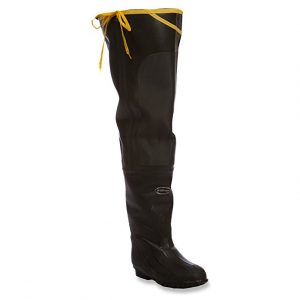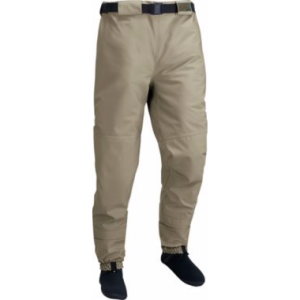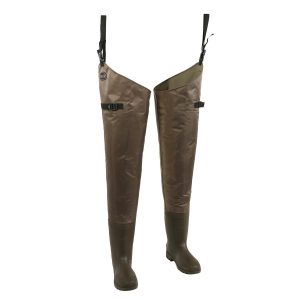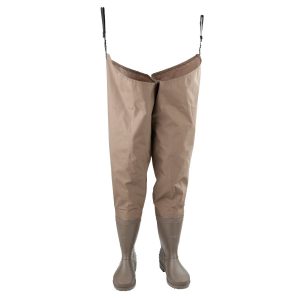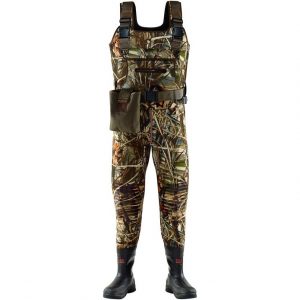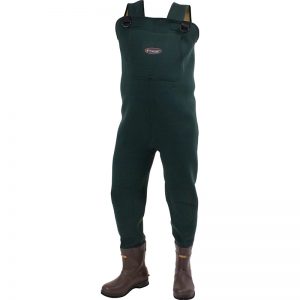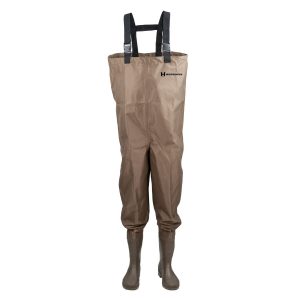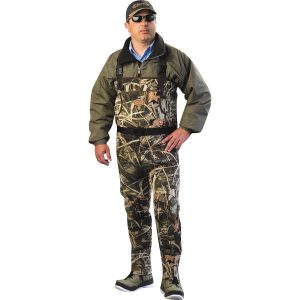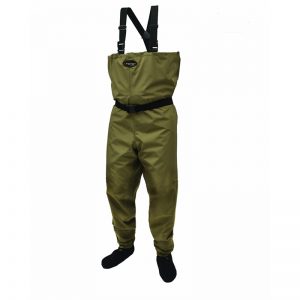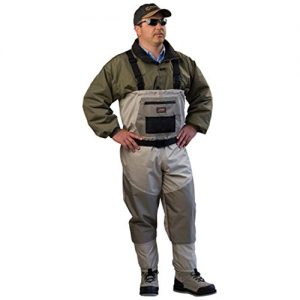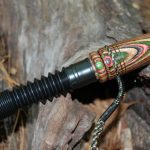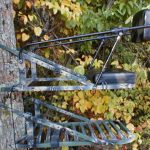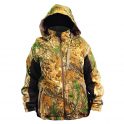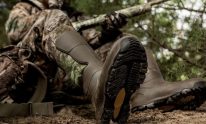Similar Articles
What are hunting and fishing waders and why are they necessary?
Duck hunting has always been a popular hunting sport, but in recent years its popularity has really surged. For anyone who has not spent time in the cold marshes where the best duck hunting can be found, you might not be familiar with the various types of waders available.
Fishermen have chased trout and salmon in cold waters for as long as there have been hooks and lines. Keeping dry and warm while doing so is paramount for being able to remain in the field for extended periods.
There are two main types of waders: Hip waders and chest waders. In the most simplistic definition, each of these types of waders goes as high as its name, hip waders to the hip and chest waders to the top of the chest.
Within each of these two groups, there are two additional categories: Stocking waders and boot waders. Stocking waders are designed to be worn inside of wading boots, which are purchased separately. Boot waders are waders that have the boots built in and socks are worn underneath.
back to menu ↑So what are hip waders?
Hip waders are waders that come up to the hips at their highest point. They are generally cut lower on the inseam and have belts loops to attach to your belt on the outer side which is what keeps them up. Some styles of hip waders use a thicker material which is designed to stay up on your leg without dropping as you walk. Hip waders are generally much less bulky and easier to maneuver in, but you have to be very careful you don’t step too deep!
back to menu ↑What are the best overall hip waders?
Top Pick: LaCrosse Men’s Trapline Hip Waders
LaCrosse is a company that has long been known for their quality outdoor gear. The Trapline Hip Waders are made from an all-natural, hand crafted rubber upper, which provides for a 100% waterproof, scent free construction. They have a wool felt lining to provide a natural, yet effective layer of insulation. The attached boots are designed with the Trac-Lite outsole, specifically designed to help prevent slipping on mossy river rocks. The boots also have a top lacing system to help keep them in place as well as a cushioned EVA insole to cushion the blow, should you step on sharp rocks. The insole is also removable to allow for complete drying of any sweat in between uses. These waders are actually constructed from a stiff enough rubber that they will stay up without having to attach them to your belt. There are strings on either side should you desire to have that extra bit of help in holding them up.
PROS:
|
CONS:
|
Second Pick: Cabela’s Premium Breathable Stockingfoot Waders, Waist High
Cabela’s has introduced a rather unique offering in the world of waders with these stockingfoot waders. Rather than the traditional hip waders that are separate for each leg, these actually are worn just like a pair of pants. This provides a great advantage over traditional waders as they will keep you dry all the way to the waist. The feet are actually neoprene booties that allow for full flexibility and ease of movement. Many folks we have spoken with have the need to actually hike for very long distances before they even enter the water. These are perfect waders if that is something you routinely do…you will simply feel like you are wearing a pair of long hiking pants. Keep in mind when purchasing these waders, that like all stockingfoot waders, you will need to also purchase a good pair of wading boots to go over the feet.
PROS:
|
CONS:
|
What are the best budget duck hunting hip waders?
Top Pick: Allen Black River Bootfoot Hip Waders
The Allen Black River Bootfoot waders are offered at an excellent price point when compared to many of the more expensive brands. These waders come with the boot as part of the wader, so there is basically nothing else you need to buy, other than a good pair of wool socks, maybe. They are very lightweight but seem to hold up quite well, even for a couple of seasons. The boots are not heavy duty, but should serve most folks well that aren’t in too harsh of terrain. They have a cleated sole to help grip rough terrain, but keep in mind there is no steel shank or any other reinforcement. One nice feature of these waders is that they are big enough to fit over heavy pants, yet they are not so baggy as to be unwieldy. This allows you to dress for the occasion, whether light pants for warmer water, or heavier layers for those cold areas.
PROS:
|
CONS:
|
Second Pick: Hodgman Mackenzie Cleated Nylon/PVC Bootfoot Hip Waders
Hodgman has really hit the mark for an affordable pair of bootfoot hip waders. The price point is very reasonable for the budget minded hunter or angler. One of the key differences between these hip waders and many others is the construction. Rather than being constructed of the more traditional rubber, these are made with a tough nylon shell. One advantage of this is you will be less prone to chaffing. Another advantage is a big difference in weight…these are up to 30% lighter than comparable rubber waders. The PVC boot is also much lighter than a traditional rubber wader boot. This is going to make wearing these easier if you have to hike any distance to get to your hunting or fishing area. One thing to keep in mind with these is that they are not insulated, so you need to plan ahead with your clothing for what you will encounter in the field in terms of cooler temps.
PROS:
|
CONS:
|
What is the best material for hip waders?
The material used in the construction of hip waders can really add to, or detract from, your comfort during your outdoor excursions.
One of the most common is rubber. This is a great choice if you are not going to be in areas that are too warm. Rubber tends to be a bit tougher than other choices, so if there is a chance your backcountry time will involve any bushes with thorns or sharp ends, this may be a better choice than some of the lighter-weight options available. Rubber is generally a bit stiffer, so hip waders made from it tend to stay up on their own a bit better. If a long hike is involved, keep in mind that rubber waders and boots tend to be quite a bit heavier than some alternatives.
Nylon is the other most common material used in the construction of hip waders. Nylon has distinct advantages over rubber in that it is much more flexible, is lighter in weight, and is not as hot. Nylon would likely be the preferred choice for the hunter or angler who is going to have to make a long trek to get to their outdoor destination as it will be lighter to wear, and also allow greater flexibility should any climbing be involved. Keep in mind that most nylon offerings are not going to be well insulated, so you will need to think about your clothing more as you plan your trip.
How high do they need to be?
It would seem that this is an obvious question…they are hip waders after all, and they are generally called for when water is too deep for just boots, but not more than a couple of feet deep; but not all hip waders are created equal in terms of how high they come up.
Traditional hip waders come up the inseam to just below the crotch, and on the outside a bit higher, with straps that attach to a belt. There are some newer offerings that now fit like a pair of pants, where you might get an extra 8 inches or so of protection. That may not sound like a lot, but as anyone who has ever stepped just an inch too deep in ice cold water can tell, that can be all the difference in the world!
How much insulation do I need?
How much insulation you need is really up to you, depending on where you are going to be using the waders and during what time of the year. Having too little, or even too much insulation, can really impact your comfort in the field.
In general, the longer you are going to be exposed to cold temperatures, the more insulation you need. What is comfortable after one hour may not be so comfortable after 4 hours. Pay attention to not only how much insulation the waders have, but also how much the boots or booties have. This is critical as if there isn’t much insulation, you might need to get a larger boot size to allow for additional or thicker pairs of socks to be worn.
If you are going to be using the waders in warmer conditions, you will want to be careful that the waders you order have very little insulation. Wearing insulated waders up to your waist in warm conditions can lead you to be uncomfortable and sweaty, and even lead to potential overheating if you are not careful. Be sure you are realistic about your needs when looking at insulative qualities in waders.
Should I get stockingfoot or bootfoot hip waders?
Each of these two types of waders has their advantages and their disadvantages. Price, dexterity and convenience are the most common differentiators.
Bootfoot waders are generally the most cost effective. When you order the waders you are getting everything you need to keep you waterproof in one package. They are quick to put on and quick to take off as you simply slide your leg into and out of the wader/boot combo. They are going to offer you less dexterity as the boots are generally bulky and do not allow a lot of movement of the ankle from the way they are welded to the wader.
Stockingfoot waders require a bit more time to put on, and also require additional costs in the purchase of wading boots. To wear stockingfoot waders, you must first slide your leg into the wader, then slide the rock guard up your calf, strap on the boot, then pull the rock guard down over the top of the boot. Definitely a bit more time consuming than the bootfoot option. What you gain from it, however, is much more dexterity in the field. You are able to articulate your ankle much as you would with any boot, so hiking and climbing are much easier…and regaining your footing if you slip in the stream is also easier. As with most things in life, there is always a tradeoff.
back to menu ↑What are chest waders?
Chest waders are waders that come up to the top of the chest and are worn much like overalls would be. They are a bit more bulky, but they allow you to go through much deeper water while still keeping the wearer dry. Often times, they will even have attachment points on the front for accessories, including shotgun shell holders and duck calls.
What are the best overall chest waders?
Top Pick: LaCrosse Swamp Tuff Pro 1000G Waders
The LaCrosse Swamp Tuff Pro 1000G Waders get their name from the conditions they expect to be worn in. You can traverse a cold swamp in these and stay nice and toasty, thanks to the (again, true to the name) 1000 grams of Thinsulate they offer. They are made from a neoprene upper and a rubber boot, so you will get some decent flexibility out of this set of waders. We found them to take a bit of getting used to when putting them on as they are quite thick. We also found the boot to be a bit tight to get your foot into, but once on they were quite comfy. You really need to pay attention to your height when ordering…we found these to come up a bit high and it wouldn’t be hard to end up with chaffed armpits if you are not careful. There is a pouch designed to fit up to a full box of shot shells and also a decoy bag on the back as well.
PROS:
|
CONS:
|
Top Pick: Frogg Toggs Amphib Neoprene Bootfoot Wader
Frogg Toggs has brought forth a good neoprene wader at a reasonable price point. They are made with 3.5mm of neoprene to keep you warm, even on colder days. They offer bib style suspenders with hook and loop adjustment, so they are comfortable and easy to adjust. These offer a high back upper design, so they are even suitable for float tube use. As with other chest waders, we found these to be a bit tall under the arms. The neoprene has enough give so this isn’t a deal killer, just something you will want to be aware of. We really liked the reinforced knee, as it gives you the confidence to actually kneel on the shoreline without worry of creating a leak. The fleece lined hand warmer was nice, but for most hunting applications, you will be wearing gloves…but for fishing with bare hands, this is great!
PROS:
|
CONS:
|
What are the best budget chest waders?
Second Pick: Hodgman Mackenzie Cleated Nylon/PVC Bootfoot Chest Waders
Like the hip waders offered in the same name, the Hodgman Mackenzie waders are a good offering for the budget minded outdoorsman. One of the key differences between these waders and many others is the construction. Rather than being constructed of the more traditional rubber, these are made with a tough nylon shell. One advantage of this is you will be less prone to chaffing. Another advantage is a big difference in weight…these are up to 30% lighter than comparable rubber waders. The PVC boot is also much lighter than a traditional rubber wader. This is going to make wearing these easier if you have to hike any distance to get to your hunting or fishing area. One thing to keep in mind with these is that they are not insulated, so you need to plan ahead with your clothing for what you will encounter in the field in terms of cooler temps.
PROS:
|
CONS:
|
Third Pick: Waterfowl Wading Systems Max-5 Neoprene Stockingfoot Wader
The Waterfowl Wading Systems new chest wader is a very reasonably priced offering, especially for one that offers the flexibility yet insulation of neoprene. These also feature a tough outer nylon shell to help keep them in top condition. The knees are reinforced to allow you to kneel on the shoreline, rather than having to bend over when dealing with game. The legs are not really for those who are full framed or who lift weights…they are more for an average build. We found them to be a bit tight in the calf section. Overall, these are a good quality product and a good price point. Keep in mind that these are stockingfoot, so you need to order a good pair of wading boots to go along with these.
PROS:
|
CONS:
|
What is the best material for chest waders?
There are three basic materials used in the construction of chest waders: rubber, nylon and neoprene.
Rubber is a great choice if you are not going to be in areas that are too warm. Rubber tends to be a bit tougher than other choices, so if there is a chance your backcountry time will involve any bushes with thorns or sharp ends, this may be a better choice than some of the lighter-weight options available. If a long hike is involved, keep in mind that rubber waders and boots tend to be quite a bit heavier than some alternatives.
Nylon is another common material used in the construction of chest waders. Nylon has distinct advantages over rubber in that it is much more flexible, is lighter in weight, and is not as hot. Nylon would likely be the preferred choice for the hunter or angler who is going to have to make a long trek to get to their outdoor destination as it will be lighter to wear, and also allow greater flexibility should any climbing be involved. Keep in mind that most nylon offerings are not going to be well insulated, so you will need to think about your clothing more as you plan your trip.
The third common material is neoprene. Neoprene generally offers a higher level of insulation than either rubber or nylon. It is more flexible than rubber or nylon, but can also be more difficult to put on and take off. Neoprene is generally not a good choice for warm weather application due to its insulative quality, but is an excellent choice for cooler weather where a high level of dexterity is required.
How much insulation do I need?
How much insulation you need is really up to you, depending on where you are going to be using the waders and during what time of the year. Having too little, or even too much insulation, can really impact your comfort in the field.
In general, the longer you are going to be exposed to cold temperatures, the more insulation you need. What is comfortable after one hour may not be so comfortable after 4 hours. Pay attention to not only how much insulation the waders have, but also how much the boots or booties have. This is critical as if there isn’t much insulation, you might need to get a larger boot size to allow for additional or thicker pairs of socks to be worn.
If you are going to be using the waders in warmer conditions, you will want to be careful that the waders you order have very little insulation. Wearing insulated waders up to your waist in warm conditions can lead you to be uncomfortable and sweaty, and even lead to potential overheating if you are not careful. Be sure you are realistic about your needs when looking at insulative qualities in waders.
Should I get stockingfoot or bootfoot chest waders?
Each of these two types of waders has their advantages and their disadvantages. Price, dexterity and convenience are the most common differentiators.
Bootfoot waders are generally the most cost effective. When you order the waders you are getting everything you need to keep you waterproof in one package. They are quick to put on and quick to take off as you simply slide your leg into and out of the wader/boot combo. They are going to offer you less dexterity as the boots are generally bulky and do not allow a lot of movement of the ankle from the way they are welded to the wader.
Stockingfoot waders require a bit more time to put on, and also require additional costs in the purchase of wading boots and rock guards. To wear stockingfoot waders, you must first slide your leg into the wader, then slide the rock guard up your calf, strap on the boot, then pull the rock guard down over the top of the boot. Definitely a bit more time consuming than the bootfoot option. What you gain from it, however, is much more dexterity in the field. You are able to articulate your ankle much as you would with any boot, so hiking and climbing are much easier…and regaining your footing if you slip in the stream is also easier.
Do they come with a cinch belt?
Chest waders cover a lot of your body and as such they have a lot of potential volume to fill with water if you happen to step a bit too deep. It is always critical that you wear some type of belt around your waist or chest, outside of the wader, that you can cinch up with one hand in a single quick motion. This will not stop water from leaking in should you step too deep, but it will keep water from flooding in, creating a potentially dangerous drowning hazard.
back to menu ↑So what are stocking foot waders?
Stocking foot waders are waders that do not have an integrated boot. They will typically have either a neoprene bootie or a stocking foot made of the same construction as the rest of the wader. This design means an extra cost of having to buy a wading boot, but can also allow for greater flexibility as you can get wading boots with different sole materials for different applications.
What are the best overall stocking foot waders?
Top Pick: Frogg Toggs Canyon Taslan Stockingfoot Wader
The Frogg Toggs Canyon Taslan waders are very lightweight and comfortable to wear. These are a great choice if you have a long hike to get to your fishing or hunting waters. They are offered at a very reasonable price point, especially when compared to a lot of other products made by Frogg Toggs. It is important to note that if you are going to use these for hunting, there is no pouch or pocket in front to store ammunition, so you will want to get some type of sling to keep your shot shells handy. It is a nice feature that these come with a cinch belt built in, ensuring you always have it on you in the event it is ever needed. These are not heavily insulated, so keep that in mind if you are going to be in extremely cold conditions. Also, remember that these are stockingfoot waders, so you will need to be sure you order a good set of wading boots to go with them.
PROS:
|
CONS:
|
Second Pick: Caddis Tauped Deluxe Stockingfoot Wader
The Caddis Tauped Deluxe wader offers a polyester outer material to help keep you dry as it will wick the sweat away from your skin. It was a pleasant change to see the number of different sizes this wader is available in to allow for a variety of body sizes for both men and women. The waders feature a double knee and easily adjustable suspenders. The feet are double taped, then glued over the stitching to keep leaks at bay. One aspect of breathable waders to consider is that the same technology that allows water out, can sometimes allow water in if the waders are worn in deep water for extended periods. That high level of water pressure over time can allow a small amount in…not enough to fill the waders, but enough to get you a bit wet. As with all stockingfoot waders, don’t forget to order a pair of good wading boots!
PROS:
|
CONS:
|
What should you look for when selecting stocking foot waders?
Stockingfoot waders, like any wader, are going to be available in a variety of materials. See the section above for more detail on materials and their differences.
The most critical aspect to consider when ordering a stocking foot wader is the construction of the bootie. Some are going to be an insulated neoprene while others may be the same material as the upper. Knowing your requirements in terms of insulation as well as evaluating how well the bootie is attached to the wader are going to be critical to your comfort.

